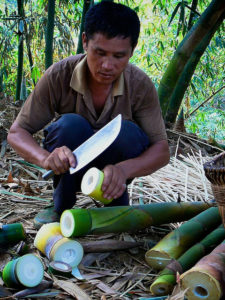
It’s a bit ironic that while wild foraged ingredients are increasingly popping up on Michelin-starred menus around the world, the communities who have traditionally subsisted on these foods are consuming them less and less.
Baobab fruit and bush mango for vitamins and minerals; bushmeat for fats and micronutrients; bamboo shoots for fiber; ferns for complex carbohydrates and various essential oils — these are just a few of the nutritious and diverse food sources that have long been staples in the diets of rural communities living in and around forests.
But as deforestation and plantations replace them, less access to forests coupled with newfound income means that these natural pantries aren’t being used the way they once were.
Sustainable Forestry and Food Security and Nutrition, a new report commissioned by the Center on World Food Security (CFS), to which the CGIAR Research Program on Forests, Trees and Agroforestry (FTA) contributed knowledge and science, takes a deep look at the interplay between sustainable forestry and food security and nutrition — a topic that has, up to this point, lacked the focus of substantial socialized research.
A High Level Panel of Experts (HLPE) consisting of scientists and specialists on food security and nutrition used information gathered from forest landscapes worldwide to test the hypothesis that the sustainable use of forests leads to better health and diets of communities within their proximity.
Read also: High Level Panel of Experts launches landmark report on sustainable forestry

QUALITY AND QUANTITY
“By 2050, there will be an estimated nine billion people in the world,” says FTA scientist Terry Sunderland, who is also Principal Scientist at the Center for International Forestry Research (CIFOR) and head of the HLPE team.
“In response to the growth in global population and incomes, and to the evolution of diets, a continuation of recent trends would imply global agricultural production in 2050 to be significantly higher than present. However, with the findings of this report we would hope such expansion would take into account the critical role of forests and trees for food security and nutrition.”
As the research goes to show, this means mitigating pressures from the increasing demand for timber and wood products in order to help communities — largely rural and smallholder farmers — conserve their forests and continue using them as food sources in a sustainable way.
The natural biodiversity of forests leads to more variation in diets, which results in better nutrition rather than simply increasing caloric intake.
“At CIFOR, our research found that people living in proximity to forests and tree-based landscapes have better diets than their compatriots, regardless of poverty,” says Sunderland. “Wild vegetables, snails, numerous other sources of micro-nutrients and proteins are incredibly important and cannot be underestimated.”
In addition to the direct foods they provide, forests also have immense effects on the sustenance of agriculture in their proximity. They host the pollinators that help many of our agricultural crops reproduce. They also help purify water, support grazing livestock, provide traditional forms of medicine and healthcare and supply wood – the primary source of fuel for one-third of the world’s population. Without energy for cooking, food would be far less palatable and water would remain unsterilized.

However, the positive effects of forests on agricultural production can lead to a tricky paradox. As plantation cash crops such as oil palm and wheat thrive, more money is put into the pockets of local communities, allowing them to purchase rather than grow or gather their food.
This can often result in their replacing produce with simple carbohydrates, refined sugars, and trans-fats – a dietary transition that isn’t accompanied by dietary education. More modern renditions of food sovereignty, in other words, can lead to unhealthier diets.
“This is a very strong trend all over the world — this middle class aspiration and the fast food obsession,” says Sunderland. “In Indonesia, for example, incidents of stunted growth is very high due to poor diets.”
TO WHOM IT MAY CONCERN
A less obvious but no less important goal of this report is to break down the barriers between the agricultural, forestry, nutrition and conservation communities and increase cross-sector collaboration in order to best tackle this issue. The HLPE report will hopefully encourage experts from different fields to harmonize their research, knowledge, and policy goals.
“If we’re serious about global food security, we can’t ignore the role of forests and trees in direct provisioning. We want the nutritionists to understand the importance of forests and trees, and we want the forestry community to understand why and how trees contribute to nutrition.”
Furthermore, when looking at forests as a major source of sustenance for local communities, it leads to the fact that denying or limiting communities’ access to them directly correlates to their access to food and water. This raises major issues of human rights with regard to food access.
“The right to food is enshrined in almost every [multilateral] agreement since 1945,” says Sunderland. “If we’re generating evidence that forests are really important to the provision of food and nutrition, how can we justify preventing people access to them?”
Read also: What’s causing the holdup in REDD+ results-based finance?
This perspective will ideally help escalate the findings of this report — which will be further discussed at the Association of Tropical Biology Conference held this week in Merida, Mexico — to influence global initiatives, such as the Sustainable Development Goals and REDD+.
But first and foremost, it aims to change conventional wisdom about food security and forests. Rather than being in competition with one another, the two are more critical to the other’s existence than we previously thought.
By Gabrielle Lipton, originally published at CIFOR’s Forests News.
The Sustainable Forestry and Food Security and Nutrition report was commissioned by the Committee on World Food Security.
For more information on this topic, please contact Terry Sunderland at t.sunderland@cgiar.org.
This research forms part of the CGIAR Research Program on Forests, Trees and Agroforestry.











